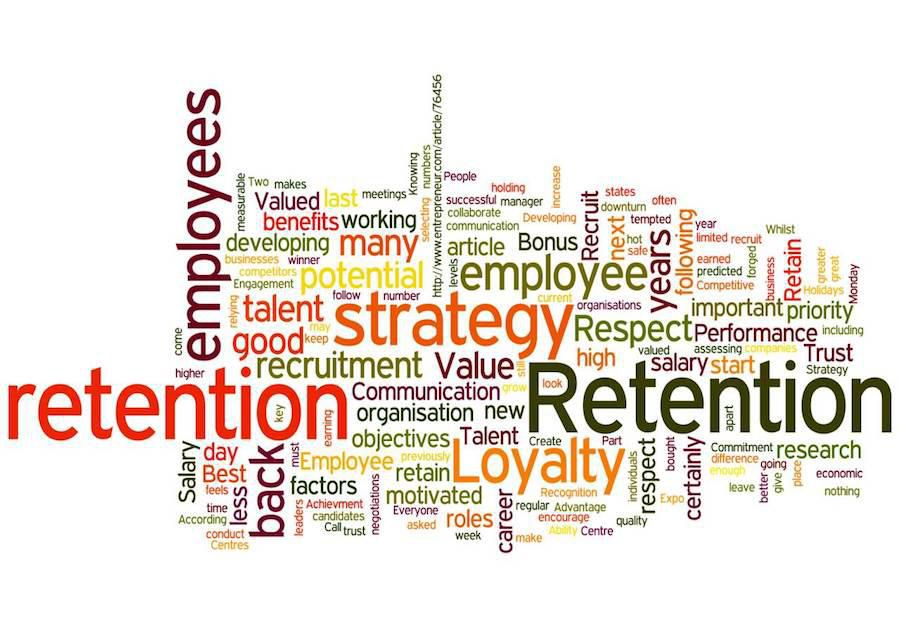Pt 4 of Building a Talent Pipeline For a Fast Recovery in a Post Pandemic World
Employee Retention
How Companies Retain Top Performers
Attracting talent is a challenge for companies – retaining them is an art: What do organizations need to keep in mind in order to prevent employee turnover? For companies, a shortage of skilled employees means having to invest time and money in retaining their top performers to prevent them from switching to a more attractive employer, or even nipping the thought in the bud. These kinds of strategies and initiatives are summarized under the term “retention management”.
The better the selection, the simpler the retention. Retention management includes all of the things a company can do to foster an employee’s loyalty to the company. Employee retention does not begin on the first day of work. The foundation is laid during the selection process with the right candidate experience for a long-lasting affiliation between employee and company. HR specialists are responsible for identifying those candidates whose profiles best fit the company. An applicant who seems highly talented but does not bring a set of realistic expectations will be difficult to keep. Once a decision is made that a candidate has the right skills to help the company, one therefore has to ask whether the candidate will be able to find personal fulfilment and satisfaction within it. One way to answer this question is to check the alignment of the candidate’s expectations with the Employer Value Proposition (EVP).
Satisfaction – The Basis of All Loyalty
As sociologists Timothy Butler and James Waldrop have discovered: There are three primary factors that will determine employee satisfaction on the job: skills, moral values, and interests. In order to feel satisfied, an employee needs to bring the right competences and skills for their job. A feeling of incompetence triggers defence mechanisms or tendencies to withdraw. The company’s moral values and its rewards system have to align with the values of the employee and be recognized by the employee as fair. Financial incentives, the creation of a good atmosphere, or recognition and career are three entirely different reward models – and here, there is high potential for conflict. In addition, daily tasks should closely overlap personal interests if possible, since these are firmly linked to the personality and determine the natural ‘fun factor’ of the work. Surveys have shown that the salary component ranks surprisingly low when people change employers. Soft factors, which can be summarized under the umbrella term “satisfaction”, are growing in significance. If the factors specified above are fulfilled, there is a solid basis for a relationship that can then be built on through targeted initiatives.
Initiatives For Employee Retention
Any employer goodwill can be fundamentally viewed as an employee retention tool. That begins with flexible work models such as home office, part-time work, or the option to take a sabbatical. Meanwhile, many companies now offer basic food and drinks in the office, like water, fruit, and coffee. Employers can also endear themselves to employees by providing a large selection of quality products (particularly coffee). Additional benefits include offerings such as team events, company sports, subsidised gym memberships, subsidised travel costs, and other small financial incentives. The more perks are individually tailored to employees, the more strongly a feeling of appreciation develops. The best and most well-known example of a broad palette of retention tools is Google. This internet giant offers its employees working conditions that resemble a theme park – and anyone who leaves the company has to first consider giving up that wonderful work environment and its perks, making this decision all the more difficult. But, with the shift to home office working as a result of Covid-19 – employers need to come up with alternative ways to enhance the work environment of their staff.
Feedback: Costs Nothing, Delivers A Lot
A lively feedback culture is an often underestimated employee retention tool: If a top performer has already decided on leaving, unbeknownst to anyone else, it is usually too late for the company to convince them otherwise.
Those who regularly ask employees for their opinion can address growing problems early on and show an appreciation for staff well-being, which has a positive effect on retention. Exit interviews can be valuable – they provide information about grievances in the company, as well as the recruitment strategies of rival companies.
Selective Employee Retention
Employee retention initiatives cost money. A broad range of basic activities that show appreciation generally makes sense, but companies should also think about which employees are really worth investing more in. From an economic perspective, long-time top performers, young talent or managers are “more valuable” than moderately qualified, undermotivated employees. Some companies go so far as to label some of their staff “bottleneck employees”, who occupy positions and have employee profiles that there could be a shortage of in the future. Suitable junior employees are subsequently supported with customised programs designed to retain them on a long-term basis.
Support With Long Perspective
The example shows that companies that want to retain specific employees need to ask a range of questions. For example: Which employees contribute the most to the success of the company? Which employees will play an important role in the future? What areas of the company are experiencing bottlenecks? Merely retaining those who are part of the current set of high performers is short-sighted. Employee retention means strategic enterprise development, and therefore requires far-sightedness.
Employee Retention Promotes Motivation
Equating employee retention with merely preventing people from leaving overlooks an important component of the concept. Employees who feel bound to their company in a positive sense almost always show more willingness to perform than those who are open to making a change. Employee retention should therefore be regarded as the basis of employee motivation. It not only prevents staff turnover, but also promotes growth and success, which would not be possible without these tools.
Employee Retention: Good For The Employer Brand
Investments in employee retention pay off on different levels. They keep and motivate valuable employees and at the same time contribute to the employer brand. Retention management is thus an essential component of the employer branding strategy. Satisfied employees who feel like an important part of the company and are rooted in the company’s network are much more likely to be positive multipliers and automatically recruit qualified new employees from their own networks. They therefore become valuable long-term resources and at the same time, an effective public testimonial for the company.
Employee Retention Questions
• Does the candidate have the necessary skills?
• Are they properly incentivised?
• Is the candidate a long-term fit?
• Am I focusing on the right candidates?
Employer Branding: Is It Worth It?
Every one of the initiatives mentioned demands an investment of time and money: a significant presence – online or off; a targeted selection process with respectful interaction; a thoroughly developed value proposition, which ensures transparency in the company; and incentives and advancement programs for the retention of top performers. The bottom line is, you can summarise all of these activities in one word: appreciation. The more clearly a company relates a person’s knowledge and skills to its economic success, the more strongly that person will feel appreciated. Only an employee who feels respected, supported, and appreciated from day one will give their employer 100% and positively promote the image of the company to the outside – over the long haul. Organisations that put investments in things before investments in their employees are too short-sighted and look for savings in the wrong places. Good employees are the most valuable capital a company can have.

Missed Pt 3? Click here
With thanks to Personio.


